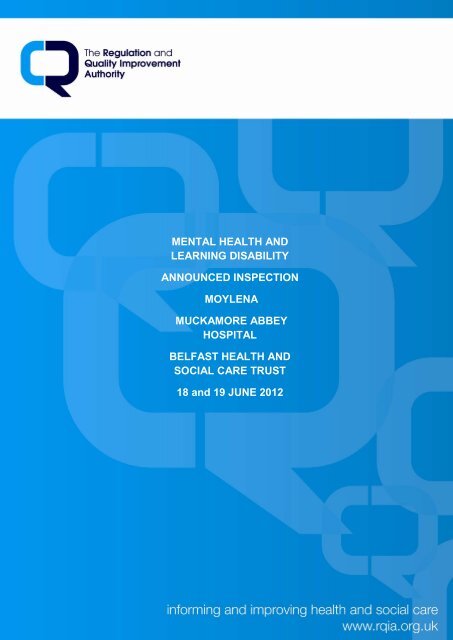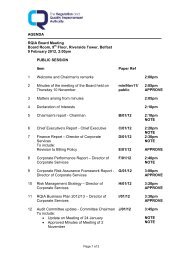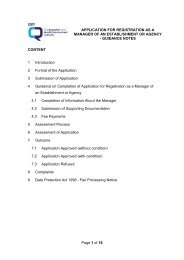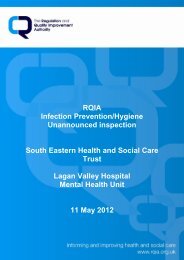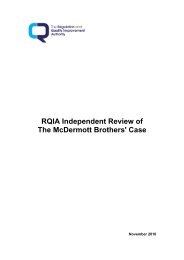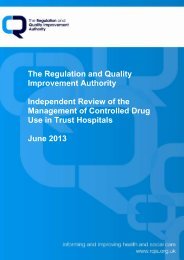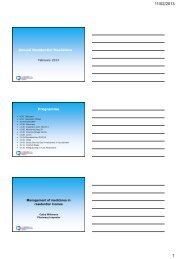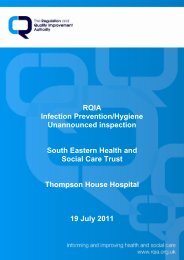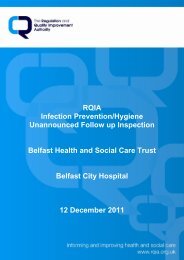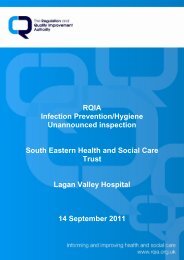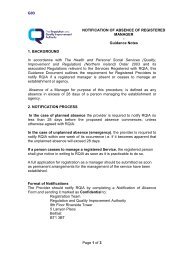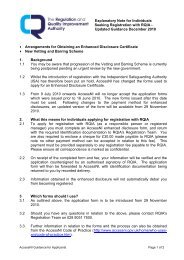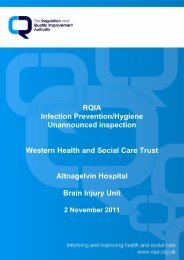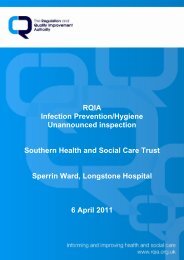Moylena, Muckamore Abbey Hospital - Regulation and Quality ...
Moylena, Muckamore Abbey Hospital - Regulation and Quality ...
Moylena, Muckamore Abbey Hospital - Regulation and Quality ...
Create successful ePaper yourself
Turn your PDF publications into a flip-book with our unique Google optimized e-Paper software.
MENTAL HEALTH AND<br />
LEARNING DISABILITY<br />
ANNOUNCED INSPECTION<br />
MOYLENA<br />
MUCKAMORE ABBEY<br />
HOSPITAL<br />
BELFAST HEALTH AND<br />
SOCIAL CARE TRUST<br />
18 <strong>and</strong> 19 JUNE 2012<br />
1
Table of Contents<br />
1.0 Introduction ............................................................................................ 3<br />
2.0 Ward Profile ........................................................................................... 4<br />
3.0 Inspection Summary .............................................................................. 6<br />
4.0 Stakeholder Engagement ....................................................................... 8<br />
5.0 Additional Concerns Noted by Inspectors ............................................ 10<br />
6.0 RQIA Compliance Scale Guidance ...................................................... 18<br />
7.0 Summary of Compliance – RQIA Assessment ................................... 120<br />
Appendix 1 – <strong>Quality</strong> Improvement Plan ........................................................ 22
1.0 Introduction<br />
The <strong>Regulation</strong> <strong>and</strong> <strong>Quality</strong> Improvement Authority (RQIA) is the independent<br />
body responsible for regulating <strong>and</strong> inspecting the quality <strong>and</strong> availability of<br />
Northern Irel<strong>and</strong>’s health <strong>and</strong> social care services. RQIA was established<br />
under The Health <strong>and</strong> Personal Social Services (<strong>Quality</strong>, Improvement <strong>and</strong><br />
<strong>Regulation</strong>) (Northern Irel<strong>and</strong>) Order 2003, to drive improvements for<br />
everyone using health <strong>and</strong> social care services.<br />
On 21 October 2011 RQIA informed the Belfast Health <strong>and</strong> Social Care Trust<br />
of the inspection <strong>and</strong> forwarded the associated inspection documentation.<br />
RQIA adopted the approach of self-assessment, which allowed the ward the<br />
opportunity to demonstrate its ability to deliver a service against best practice<br />
indicators. This included the assessment of the trust’s performance against<br />
an RQIA compliance scale, as outlined in section 6.<br />
The inspection process included an analysis of the ward’s self-assessment,<br />
other associated information, discussions with hospital staff, the ward<br />
advocate <strong>and</strong> patients’ relatives. A range of multidisciplinary records, policies<br />
<strong>and</strong> procedures were also examined as part of the inspection.<br />
The recommendations made during the previous inspection on 14 <strong>and</strong> 15<br />
November 2011 were also assessed during this inspection to determine the<br />
trust’s progress towards compliance. The inspector found evidence of quality<br />
improvement in the following areas:<br />
• The independent advocate had been to the ward <strong>and</strong> had met with<br />
ward staff. A group advocacy approach has been taken <strong>and</strong> there had<br />
been a quality service improvement meeting held on the ward involving<br />
the advocate.<br />
• The routines on the ward had been modified to ensure individual<br />
access to the bathroom areas.<br />
• Some new seating had been provided within the day areas.<br />
• The specific night time needs of one patient had been reviewed by the<br />
multidisciplinary team <strong>and</strong> input had been sought by behaviour support<br />
services, speech <strong>and</strong> language therapy <strong>and</strong> occupational therapy.<br />
• Patients’ relatives were being provided with additional opportunities to<br />
express their views on the quality of care provided.<br />
Inspectors will continue to monitor these areas of quality improvement <strong>and</strong><br />
have been assured that these developments will be sustained.<br />
An overall summary of the ward’s performance against the human rights<br />
theme of protection is in section 3 <strong>and</strong> full details of the inspection findings are<br />
outlined in Appendix 2.<br />
3
2.0 Ward Profile<br />
Trust<br />
Name of hospital/facility<br />
Address<br />
Belfast Health <strong>and</strong> Social Care Trust<br />
<strong>Muckamore</strong> <strong>Abbey</strong> <strong>Hospital</strong><br />
1 <strong>Abbey</strong> Road<br />
Antrim<br />
BT41 4SH<br />
Telephone number 028 94463333<br />
Person in charge on day of<br />
inspection<br />
Email address (Ward Manager)<br />
Liam McCormick<br />
adrienne.creane@belfasttrust.hscni.net<br />
Nature of service - MH/LD<br />
Name of ward/s <strong>and</strong> category of<br />
care<br />
Learning Disability<br />
<strong>Moylena</strong><br />
Number of patients <strong>and</strong> occupancy<br />
level on days of inspection<br />
17 patients, ward has capacity for 18<br />
patients<br />
Number of detained patients on<br />
days of inspection<br />
0<br />
Date of last inspection 14 <strong>and</strong> 15 November 2011<br />
Name of Inspectors<br />
Audrey Murphy<br />
Janet McCusker<br />
<strong>Moylena</strong> is a two-storey inpatient facility on the <strong>Muckamore</strong> <strong>Abbey</strong> <strong>Hospital</strong><br />
site. The ward provides accommodation for 18 adult male patients, many of<br />
whom have been receiving inpatient care on the hospital site for up to 50<br />
years.<br />
4
One patient has been discharged from the ward since the last inspection.<br />
Inspectors were advised that the community integration project will be having<br />
input with the remainder of the <strong>Moylena</strong> patients commencing in 2013.<br />
The sleeping accommodation is upstairs <strong>and</strong> can be accessed by two flights<br />
of stairs or by a lift. There are four single rooms available <strong>and</strong> the remainder<br />
of patients sleep in an open dormitory. There are two bathrooms upstairs<br />
also.<br />
On the ground floor of the ward patients have access to one of three day<br />
rooms, a dining room <strong>and</strong> a toilet area. Each of the day areas has access to<br />
the ward’s enclosed outdoor area, some of which has a soft surface.<br />
All of the patients have access to five sessions of day care per week provided<br />
on the hospital site.<br />
Medical cover is provided by a consultant psychiatrist <strong>and</strong> a senior house<br />
officer.<br />
Patients have input from hospital based physiotherapy, podiatry, dental <strong>and</strong><br />
dietetics services. Patients can also access speech <strong>and</strong> language therapy<br />
<strong>and</strong> inspectors were advised that patients could be referred to community<br />
based occupational therapy services.<br />
Staffing on the ward is provided by a ward manager, b<strong>and</strong> 5 nursing staff <strong>and</strong><br />
a number of b<strong>and</strong> 2 <strong>and</strong> b<strong>and</strong> 3 staff. A student nurse was on placement on<br />
the ward at the time of the inspection.<br />
5
3.0 Inspection Summary<br />
The announced inspection was undertaken on 18 <strong>and</strong> 19 June 2012 <strong>and</strong><br />
included Audrey Murphy <strong>and</strong> Janet McCusker.<br />
The inspection was facilitated by Liam McCormick (staff nurse) <strong>and</strong> inspectors<br />
had access to all areas of the ward <strong>and</strong> to a range policies, procedures, care<br />
records <strong>and</strong> other documentation maintained by the ward.<br />
The purpose of this inspection was to assess the ward’s arrangements <strong>and</strong><br />
procedures for safeguarding vulnerable adults.<br />
The following is a summary of the inspection findings in relation to the<br />
arrangements for safeguarding vulnerable adults on the ward.<br />
There were 17 patients present on the ward at the time of the inspection.<br />
Patients were observed using the day areas <strong>and</strong> were all reported to have<br />
attended day care for a daily session.<br />
The ward maintains a range of policies <strong>and</strong> procedures in relation to<br />
safeguarding vulnerable adults <strong>and</strong> has developed guidelines for staff. A<br />
number of staff have received training in this area, <strong>and</strong> there was evidence of<br />
staff’s underst<strong>and</strong>ing of adult protection concerns. It was recommended that<br />
a number of trust policies are reviewed, in accordance with the trust schedule<br />
for policy review.<br />
A range of safeguarding documentation in relation to specific concerns was<br />
examined <strong>and</strong> inspectors noted detailed <strong>and</strong> timely recording <strong>and</strong> reporting of<br />
concerns. There was also evidence of risk assessments <strong>and</strong> care plans being<br />
reviewed in light of identified concerns.<br />
Staff were noted to have received training in many of the m<strong>and</strong>atory area.<br />
However, it was recommended that all staff undertake training in safeguarding<br />
vulnerable adults, infection control, patients’ finances <strong>and</strong> child protection.<br />
The patients’ care records contained detailed needs assessments <strong>and</strong> care<br />
plans which had been reviewed on a regular basis. Recommendations were<br />
made in relation to the completion of comprehensive risk assessments <strong>and</strong><br />
daily recording of patients’ progress.<br />
The ward maintains records of incidents occurring on the ward. Patients’<br />
relatives advised inspectors that they were informed of any incident or<br />
accident. Relatives who participated in the inspection also indicated they<br />
knew how to make a complaint or raise a concern. It was recommended that<br />
patients <strong>and</strong> their representatives are advised of the arrangements for<br />
accessing information held by the ward in relation to them.<br />
6
There were a number of restrictive practices being implemented by ward staff<br />
in response to assessed needs of patients. The patients’ care records<br />
reflected risk assessments <strong>and</strong> care plans in relation to restrictions. However,<br />
as patients were receiving care in groups, there was evidence of some<br />
patients experiencing restrictions due to the needs of their peers.<br />
There were records of physical interventions used on the ward <strong>and</strong> evidence<br />
of these being audited. Physical intervention records also highlighted the use<br />
of restraint for a patient who required support to provide a blood sample. The<br />
patient’s rights were discussed at length with ward staff <strong>and</strong> a<br />
recommendation was made in relation to safeguarding the rights of patients<br />
who lack capacity to consent to interventions.<br />
All patients on the ward were noted to require significant support to manage<br />
their finances. The ward maintains procedures for safeguarding patients’<br />
money <strong>and</strong> property. It was recommended that all staff receive training in this<br />
area <strong>and</strong> that the procedures are fully implemented.<br />
In the course of this inspection a number of concerns were noted <strong>and</strong> outlined<br />
within the report. These relate to: the quality of the ward environment; care<br />
practices; activities; nursing documentation; leadership; quality of life <strong>and</strong><br />
learning <strong>and</strong> development. These issues were discussed at a feedback<br />
meeting at the end of the inspection with senior hospital staff.<br />
The inspectors would like to thank the patients, hospital staff <strong>and</strong> relatives<br />
who participated in the inspection.<br />
7
4.0 Stakeholder Engagement<br />
Questionnaires were issued to staff, patients, relatives/ carers <strong>and</strong> visiting<br />
professionals in advance of the inspection. The responses from the<br />
questionnaires were used to inform the inspection process.<br />
Questionnaires issued to Number issued Number returned<br />
Patients 17 0<br />
Carers/Relatives 17 4<br />
Visiting Professional 5 1<br />
Staff 10 6<br />
During the inspection the inspectors had the opportunity to meet with staff,<br />
patients, relatives/ carers, <strong>and</strong> advocates. Below are the details of the<br />
number of discussions held during the inspection.<br />
Additional discussions during inspection<br />
Number<br />
Patients 0<br />
Carers/Relatives 3<br />
Visiting Professionals 1<br />
Staff 5<br />
Advocates 1<br />
The following information is a summary of feedback received from those who<br />
returned a questionnaire or met with an inspector during the inspection.<br />
Patients<br />
Inspectors did not interview patients individually, however, observed patients<br />
in the day spaces on the ward. The patients appeared relaxed <strong>and</strong> at ease.<br />
Some were noted to be sleeping when inspectors visited the patients’ day<br />
areas. Staff were present within the day spaces <strong>and</strong> were engaging with<br />
patients in a friendly manner.<br />
Carers/ Relatives<br />
Inspectors met with three patients’ relatives during the inspection <strong>and</strong><br />
received written feedback from four relatives. All of the relatives who<br />
participated in the inspection provided positive feedback <strong>and</strong> spoke highly of<br />
the ward staff. Relatives also indicated that they knew how to raise concerns<br />
if they had any, <strong>and</strong> that the ward sister would be their first point of contact.<br />
Suggestions for quality improvement made by relatives included: more outings<br />
for patients; more access for relatives to patients’ living / sleeping areas; <strong>and</strong><br />
more information about the community integration project <strong>and</strong> how it will<br />
impact on patients in <strong>Moylena</strong>.<br />
8
Some comments made by patients’ relatives included:<br />
• “Overall I am very happy with <strong>Muckamore</strong> <strong>and</strong> I think the staff are<br />
mostly excellent”.<br />
• “Staff are friendly <strong>and</strong> helpful at all times”.<br />
Visiting professionals<br />
One visiting professional contributed in writing to the inspection <strong>and</strong> indicated<br />
that they visit the ward monthly. Feedback received by the visiting<br />
professional was positive <strong>and</strong> reflected no areas of concern or suggestions for<br />
quality improvement.<br />
Staff<br />
Inspectors met with five staff during the inspection <strong>and</strong> received written<br />
feedback from six staff. All staff who participated in the inspection indicated<br />
that they had received m<strong>and</strong>atory training <strong>and</strong> were aware of how to raise<br />
concerns.<br />
Suggestions for quality improvement included more recreation activities for<br />
patients, more of a cosy, homely feeling in the day rooms,<br />
• “I believe that the level of care in this ward is very good <strong>and</strong> the<br />
patients are very happy here”.<br />
• The care provided is of a high st<strong>and</strong>ard.”<br />
• “Excellent care from a dedicated team.”<br />
9
5.0 Additional Concerns Noted by Inspectors<br />
There were a number of serious concerns raised during the previous<br />
inspection <strong>and</strong> with the Trust’s chief executive <strong>and</strong> senior management<br />
following the inspection. These related to the ward environment, care<br />
practices <strong>and</strong> activities for patients. Trust staff provided RQIA with verbal <strong>and</strong><br />
written assurances that these areas for quality improvement would be<br />
addressed in a timely manner.<br />
The following is an assessment of progress towards compliance.<br />
5.1 <strong>Quality</strong> of the Ward Environment<br />
Inspectors toured the upstairs of the ward with senior hospital staff. This<br />
contains the dormitory area, four single bedrooms <strong>and</strong> two bathroom areas.<br />
Inspectors were advised that patients do not have access to the upstairs<br />
areas of the ward during the day.<br />
It was noted that these areas of the ward were warm <strong>and</strong> clean <strong>and</strong> there was<br />
some painting in progress. Ward staff had reported a leaking toilet to the trust<br />
estates department. There was evidence that in spite of cleaning, the leak<br />
had caused staining to the floor area.<br />
Inspectors were shown both bathroom areas, one of which contained a bath<br />
<strong>and</strong> a shower. The other bathroom currently contains a shower <strong>and</strong> has been<br />
identified as requiring refurbishment, including the provision of a bath. Ward<br />
staff advised inspectors that the provision of an additional bath on the ward<br />
will provide patients with more choice.<br />
The single rooms contained only a bed <strong>and</strong> a wardrobe. Two rooms had<br />
some of the patients’ family photos wall mounted. One of the single rooms<br />
had been vacated by a patient who had been resettled <strong>and</strong> was being used<br />
for storage while the ward was being painted.<br />
The large dormitory contains 13 beds, seven of which are on one side with the<br />
remainder separated by <strong>and</strong> accessible through a central nurses’ station.<br />
This was noted to contain a variety of seating, some of which was damaged.<br />
Inspectors were advised that some patients would use the nurses’ station to<br />
wait their turn for the bathroom. It was noted that with the exception of the<br />
seating in the nurses’ area, there were no other chairs for patients’ use in the<br />
dormitory.<br />
Each patient’s bed space consisted of only a bed <strong>and</strong> a wardrobe nearby. All<br />
of the wardrobes were locked <strong>and</strong> patients did not have ready access to their<br />
property. Patients do not have drawer space or a bedside locker or anywhere<br />
to store or set personal items.<br />
10
The bed linen in use throughout the ward was noted to be very similar for<br />
each patient <strong>and</strong> there were no soft furnishings at the bed spaces.<br />
There were no patient identifiable objects or personal belongings in sight<br />
within the dormitory, nor were there any pictures of patients, their family or of<br />
their interests. Inspectors were advised that all of the patients’ personal<br />
property was contained in their locked wardrobes, which they were allowed to<br />
look in in the mornings. On inspection it was noted that wardrobes contained<br />
only clothing.<br />
Inspectors noted few mirrors in the dormitory <strong>and</strong> there were no fixed or<br />
portable screens between or in the area of the bed spaces. Lighting in the<br />
dormitory was overhead strip lighting. Patients have no control of this, not<br />
individual lights within their bed space areas.<br />
It was evident that little progress had been made in relation to the provision of<br />
privacy measures within the dormitory area. There were no screens or<br />
curtains for patients’ use between or around the individual bed spaces.<br />
Recommendations in relation to the window coverings had not been taken<br />
forward. Patients continue to have no privacy when using this area.<br />
An update on the Trust’s progress towards improving the ward environment<br />
was sought. Inspectors were advised that a company had been approached<br />
in relation to providing some quotes for the supply <strong>and</strong> installation of some<br />
partitions in the dormitory area. This work had not progressed, however, <strong>and</strong><br />
funding had not been sought for the work.<br />
While assurances were given verbally <strong>and</strong> in writing that these concerns<br />
would be addressed in a timely manner, it would appear that patients in<br />
<strong>Moylena</strong> continue to have their rights to privacy <strong>and</strong> dignity overlooked. It<br />
would not be routinely acceptable for patients or service users in any other<br />
healthcare setting to have their right to privacy <strong>and</strong> dignity denied. RQIA<br />
remain very concerned that the human rights of these patients have not been<br />
safeguarded <strong>and</strong> that the patients’ experience could be perceived as<br />
degrading.<br />
5.2 Care Practices<br />
Inspectors were advised of a recent revision in the morning <strong>and</strong> evening<br />
routines of the patients, <strong>and</strong> of the emphasis on individual use of the<br />
bathroom areas. Written guidance had been developed by the ward manager<br />
in June 2012 <strong>and</strong> reflects the arrangements for three groups of patients to<br />
have access to the bathroom areas individually.<br />
While these arrangements provide for individual access to the bathroom, they<br />
also reflect the patients’ experience of lengthy periods of time waiting for other<br />
patients to vacate the bathroom. Patients are nursed in groups <strong>and</strong> have little<br />
autonomy in relation to deciding which area of the ward to spend their time.<br />
11
The specific circumstances of one patient who was noted to be choosing to<br />
sleep on his single bedroom floor during the previous inspection were<br />
reviewed. Inspectors met with the patient’s relatives, his consultant<br />
psychiatrist <strong>and</strong> named nurse <strong>and</strong> examined a range of documentation within<br />
the patient’s care records. It was established that following the concerns<br />
raised at the previous inspection, the patient’s needs had been reviewed.<br />
Multidisciplinary input had been sought from occupational therapy, speech<br />
<strong>and</strong> language therapy <strong>and</strong> behaviour support services. The outcome of this<br />
review was not evident, however, as some assessments were pending.<br />
It was noted that the patient continued to choose to sleep on his bedroom<br />
floor <strong>and</strong> his nursing care plan contained a detailed description of this<br />
preference. The patient’s relatives were satisfied that a review of the patient’s<br />
needs had been undertaken <strong>and</strong> that their right to continue to choose to sleep<br />
on the floor had been upheld <strong>and</strong> respected.<br />
Inspectors will continue to monitor this patient’s care <strong>and</strong> treatment on the<br />
ward <strong>and</strong> to seek assurances that the patient has been provided with every<br />
opportunity to avail of the same comforts afforded to other patients, in<br />
accordance with his preferences.<br />
In the process of reviewing this patient’s sleeping needs, it was identified that<br />
the patient had experienced physical restraint as a planned intervention in<br />
order to complete venepuncture. The physical interventions records outlined<br />
the roles of four members of staff involved in restraining the patient, two of<br />
whom had responsibility for the patient’s head <strong>and</strong> legs while two used<br />
restraint techniques to control the patient’s arms. The intervention was noted<br />
to last three minutes.<br />
The patient was assessed as lacking capacity to consent to or decline<br />
venepuncture. It was reported by their consultant psychiatrist that the patient<br />
would not cooperate with having their bloods taken. This would appear to be<br />
a stressful event for the patient. Inspectors were very concerned to learn that<br />
four staff were engaged in the full control of the patient’s movement in order to<br />
proceed with this intrusive <strong>and</strong> perhaps painful intervention.<br />
Inspectors were very concerned to note that the patient’s care plan did not<br />
outline needs in this area <strong>and</strong> that there was no care plan to support this level<br />
of intervention. An inspector enquired of the patient’s relatives if they were<br />
aware of any instances of physical restraint being used with their relative <strong>and</strong><br />
reported that they were not aware of any.<br />
From discussion with the patient’s consultant psychiatrist <strong>and</strong> examination of<br />
the care records, it appeared that the blood sample required was for the<br />
purposes of anti-psychotic monitoring <strong>and</strong> that this would be undertaken twice<br />
annually. It was established that this patient had required this level of<br />
intervention for some time <strong>and</strong> with a degree of frequency <strong>and</strong> predictability.<br />
12
The patient’s capacity to consent to venepuncture was discussed. An<br />
inspector was advised that the patient lacked capacity to make decisions<br />
about this <strong>and</strong> would be uncooperative with the required procedures. The<br />
inspector identified that the patient is not formally detained on the ward under<br />
the Mental Health (Northern Irel<strong>and</strong>) Order 1986 <strong>and</strong> as such was not obliged<br />
to accept this intervention.<br />
The inspector was concerned to note that no formal best interests discussions<br />
or decisions had been taken in respect of this aspect of the patient’s care <strong>and</strong><br />
treatment. The principles of proportionality <strong>and</strong> necessity did not appear to<br />
have been explored. There was no evidence within the care records of less<br />
restrictive measures being considered or of the alternatives to venepuncture.<br />
The patient’s family did not appear to be aware of any physical interventions<br />
within the patient’s care <strong>and</strong> treatment. The patient had not been referred to<br />
the independent advocacy service.<br />
There were no apparent safeguards for this patient in relation to their rights<br />
<strong>and</strong> in the absence of such safeguards, this aspect of their care <strong>and</strong> treatment<br />
was significantly compromising the patient’s dignity.<br />
5.3 Activities<br />
Concerns raised during the previous inspection in relation to activities were<br />
discussed during this inspection <strong>and</strong>, with the exception of the recent input<br />
from a student nurse on placement, the patient’s activity assessments <strong>and</strong><br />
care plans had not been reviewed.<br />
Patients were noted to be spending the majority of their time in three specific<br />
group rooms, each of which contained soft seating, a television <strong>and</strong> access to<br />
the outdoor area. One of the group rooms was noted to be secure <strong>and</strong> was<br />
being used by five patients who were unable to leave the room. As stated<br />
previously, all of the patients were nursed in groups <strong>and</strong> as such did not have<br />
any choices in relation to which area of the ward they could spend their time.<br />
Patients were observed relaxing in the group rooms <strong>and</strong> appeared<br />
comfortable. Staff were present in each of the group rooms, however there<br />
was no evidence of the provision of activities for patients or of any meaningful<br />
engagement between staff <strong>and</strong> patients. There was an absence of any<br />
personal items or of any items or objects that might provide occupation or<br />
stimulation to patients.<br />
The ward had developed some information for patients in relation to routines<br />
<strong>and</strong> mealtimes. This had been produced in a format which was not suitable to<br />
the needs of all patients. The information on display was noted to be in small<br />
print <strong>and</strong> not immediately available to patients in all areas of the ward.<br />
13
Inspectors were advised that the hospital had secured funding for the<br />
refurbishment of the outdoor soft play area.<br />
Inspectors were advised of the arrangements for providing activities for<br />
patients. Each patient has been allocated a daily session at the hospital’s day<br />
care service at <strong>Moylena</strong>. Each session lasts around 2 – 3 hours <strong>and</strong> patients<br />
are accompanied to the day service by staff. All patients are present on the<br />
ward at meal times.<br />
The ward has recently been given exclusive access to the Portview building<br />
on the far side of the hospital site. Inspectors were advised that this would be<br />
used to provide additional day care, <strong>and</strong> would also be used in the evenings<br />
<strong>and</strong> at weekends. Ward staff informed inspectors that some refurbishment<br />
work was required within Portview prior to it being available to these patients.<br />
A timescale for this work was not indicated.<br />
A student nurse had developed provisional activity programmes for individual<br />
patients, which reflected their anticipated usage of the Portview facility.<br />
Several current activity programmes for patients were noted to be inaccurate<br />
<strong>and</strong> did not reflect their attendance at <strong>Moylena</strong>. In addition, ward staff were<br />
not maintaining records of ward based activities offered to or undertaken by<br />
patients.<br />
5.4 Nursing Documentation<br />
Inspectors examined a range of documentation including assessments <strong>and</strong><br />
nursing care plans. It was recommended during the previous inspection that<br />
nursing interventions are recorded in full on a daily basis.<br />
Inspectors were advised of the development <strong>and</strong> implementation of a<br />
st<strong>and</strong>ard for recording the patients’ progress. A senior nurse manager<br />
informed inspectors that this had been developed in conjunction with the<br />
hospital’s governance department <strong>and</strong> directs nursing staff to make a written<br />
evaluation of the patients’ progress no less that twice per week.<br />
Inspectors had been provided with an abundance of information <strong>and</strong> reports in<br />
relation to the needs of the patients in <strong>Moylena</strong> <strong>and</strong> of the challenges involved<br />
in providing safe <strong>and</strong> effective nursing care. The dependency <strong>and</strong><br />
vulnerability of this patient group necessitates regular nursing input. Staff were<br />
able to describe a range of interventions used to safeguard the patients <strong>and</strong> to<br />
promote positive outcomes for them. Indeed, inspectors were advised that<br />
many of the patients required high levels of supervision during the day <strong>and</strong> at<br />
night.<br />
14
Inspectors were of the view that given the nature, frequency <strong>and</strong> duration of<br />
these interventions, records should be maintained to reflect the interventions<br />
undertaken <strong>and</strong> the outcome of these.<br />
Inspectors noted on several progress records that entries had not been made<br />
for up to five days. One patient’s records had no entry made in relation to<br />
their progress for a 10 day period.<br />
5.5 Leadership<br />
All of the areas outlined in the previous inspection <strong>and</strong> those identified during<br />
this inspection were discussed at length with senior hospital staff.<br />
It was disappointing to note that senior staff had not invested efforts in<br />
ensuring that all of the issues pertaining to patients’ privacy <strong>and</strong> dignity on the<br />
ward had been addressed.<br />
The tour of the ward was facilitated by the head of hospital services <strong>and</strong> a<br />
senior nurse manager.<br />
Inspectors enquired if it would be possible for patients to be facilitated or<br />
encouraged to have access to their belongings or to have pictures of familiar<br />
<strong>and</strong> meaningful people or objects in their bed space area. <strong>Hospital</strong> staff were<br />
ambivalent about this prospect <strong>and</strong> did not commit to considering this.<br />
Inspectors discussed the staffing arrangements within the ward at night <strong>and</strong><br />
were advised that five staff would be on duty until 11pm, then two staff on duty<br />
overnight. Both staff would be based in the upstairs nurses’ station in the<br />
middle of the dormitory.<br />
Inspectors enquired about the risks involved in patients not being observed at<br />
all times during the night – in the event of partitions or curtains being available<br />
to them to maintain privacy. Inspectors were advised that some patients have<br />
epilepsy <strong>and</strong> would need to be observed throughout the night. Inspectors<br />
were also advised of behavioural issues that could occur – assaults by<br />
patients on other patients for example – if patients were not observable during<br />
the night.<br />
The patients’ tolerance of partitions was discussed. <strong>Hospital</strong> staff advised<br />
inspectors that due to observation levels, patients could not have partitions or<br />
other privacy measures, as this would make it difficult for patients to be<br />
observed by staff when in bed. Inspectors were very concerned about the<br />
patients’ right to privacy <strong>and</strong> enquired if all patients required this level of<br />
observation. They were advised that they did.<br />
Inspectors advised ward staff of the initiatives taken by Southern Health <strong>and</strong><br />
Social Care Trust staff in the provision of enhanced privacy measures for<br />
patients with similar needs. The provision of fixed partitions between bed<br />
spaces had been reported by Southern Trust staff as effective <strong>and</strong> well<br />
tolerated by patients. Inspectors who visited the ward subsequent to the<br />
15
provision of partitions noted a significant improvement in the amount of<br />
privacy the partitions provided patients.<br />
Inspectors enquired about the arrangements for maintaining patients’ privacy<br />
in the event of the dormitory curtains being removed or pulled down by<br />
patients. Inspectors were advised nursing staff re-hung the curtains as soon<br />
as possible. <strong>Hospital</strong> staff indicated that the previous recommendation in<br />
relation to window coverings was unnecessary as they considered that the<br />
current provision of curtains was adequate. While there were adequate<br />
curtains in place on the ward, there was a concern raised by inspectors that<br />
patients’ privacy would be compromised during the time taken to re-hang<br />
curtains. There was discussion in relation to staff having time to re-hang<br />
curtains, particularly at night or during the morning / evening peak times. It<br />
was acknowledged that re-hanging curtains frequently was time consuming as<br />
the windows were high <strong>and</strong> step ladders, which were stored in a nearby store,<br />
were required. It was agreed that some privacy glass or opaque film on the<br />
lower half of the windows would allow light into the ward <strong>and</strong> preserve the<br />
patients’ privacy.<br />
The patients’ access to <strong>and</strong> acquisition of personal items was discussed with<br />
senior hospital staff as inspectors had concerns about the austerity of the<br />
environment <strong>and</strong> the lack of personal identity for individual patients. Senior<br />
nursing staff were unable to provide any assurances that these concerns,<br />
having been raised for a second time by inspectors, would be addressed.<br />
This was very concerning.<br />
RQIA refers to a range of best practice guidance when assessing the quality<br />
of services. Inspectors have considered the Royal College of Nursing’s<br />
guidance on Dignity in Health Care for People with Learning Disabilities <strong>and</strong><br />
based several recommendations on an assessment of the trust’s<br />
arrangements for promoting dignity.<br />
Lack of privacy for patients, barren environment, lack of personal identity <strong>and</strong><br />
few personal possessions <strong>and</strong> lack of choice are highlighted as a significant<br />
indicators of an undignified experience of healthcare for individuals with<br />
learning disability.<br />
5.6 <strong>Quality</strong> of Life<br />
A number of quality of life indicators were considered in relation to the<br />
experiences of the patients in <strong>Moylena</strong>. These included the promotion of their<br />
individuality, privacy, dignity <strong>and</strong> independence <strong>and</strong> autonomy.<br />
It was disappointing to note that the patients were not experiencing care which<br />
would enhance their quality of life. They were subject to the routines of the<br />
ward <strong>and</strong> were generally receiving care in groups, rather than individually.<br />
16
In spite of having individual needs assessments <strong>and</strong> care plans, patients were<br />
experiencing the same degree of restriction <strong>and</strong> had insufficient opportunities<br />
for social interaction, stimulation or recreation. Patients were noted to not<br />
have access to any private time away from the other patients – except when<br />
escorted to the bathroom by staff. Only a few patients were described as<br />
being able to independently access the toilet without direct staff supervision.<br />
A number of patients’ care records reflected patients’ needs in relation to their<br />
sexual expression. The care records also described patients engaging in<br />
masturbation in inappropriate places. Unfortunately none of these patients<br />
have access to appropriate places for time alone <strong>and</strong> do not experience any<br />
real privacy at any time of the day or night.<br />
Many of the patients have contact with their family <strong>and</strong> receive visits from<br />
family members. Visitors to the ward generally do not have access to the<br />
patients’ living areas or to the upstairs of the ward.<br />
Some patients have very infrequent or no contact with family <strong>and</strong> thus do not<br />
receive any visitors. Access to independent advocacy services is limited <strong>and</strong><br />
at the time of inspection, no patients had individual contact with an advocate.<br />
5.7 Learning <strong>and</strong> Practice Development<br />
Having considered the quality of the environment, some of the care practices<br />
<strong>and</strong> the patients’ experiences on <strong>Moylena</strong>, inspectors were not assured that<br />
this ward would represent best practice in relation to the provision of nursing<br />
care to a group of long stay patients.<br />
Concerns highlighted during the previous inspection had not been fully<br />
addressed <strong>and</strong> inspectors were not provided with a convincing action plan that<br />
the critical issues in relation to patients’ privacy, dignity <strong>and</strong> individuality would<br />
be remedied.<br />
The allocation of student nurses to the ward, while providing the student with<br />
experience of the long stay patient group, would not provide exposure to best<br />
practice or indeed to satisfactory care practices in some instances.<br />
Update – 1 October 2012<br />
Following the announced inspection, a summary of findings was shared with<br />
senior hospital staff. Assurances were sought by RQIA in relation to the areas<br />
of concern identified during the inspection.<br />
RQIA has been assured that actions have been taken to promote patients’<br />
privacy <strong>and</strong> dignity <strong>and</strong> correspondence has been received from the ward’s<br />
consultant psychiatrist in relation to specific concerns raised.<br />
17
RQIA will continue to monitor the ward’s progress towards compliance with<br />
the recommendations made in the quality improvement plan attached to this<br />
report.<br />
18
6.0 RQIA Compliance Scale Guidance<br />
Guidance - Compliance statements<br />
Compliance statement<br />
0 - Not applicable<br />
1 - Unlikely to become<br />
compliant<br />
2 - Not compliant<br />
3 - Moving towards<br />
compliance<br />
4 - Substantially<br />
Compliant<br />
5 - Compliant<br />
Definition<br />
Compliance with this criterion<br />
does not apply to this ward.<br />
Compliance will not be<br />
demonstrated by the date of the<br />
inspection.<br />
Compliance could not be<br />
demonstrated by the date of the<br />
inspection.<br />
Compliance could not be<br />
demonstrated by the date of the<br />
inspection. However, the service<br />
could demonstrate a convincing<br />
plan for full compliance by the<br />
end of the inspection year.<br />
Arrangements for compliance<br />
were demonstrated during the<br />
inspection. However, appropriate<br />
systems for regular monitoring,<br />
review <strong>and</strong> revision are not yet in<br />
place.<br />
Arrangements for compliance<br />
were demonstrated during the<br />
inspection. There are appropriate<br />
systems in place for regular<br />
monitoring, review <strong>and</strong> any<br />
necessary revisions to be<br />
undertaken.<br />
Resulting Action in<br />
Inspection Report<br />
A reason must be clearly stated<br />
in the assessment contained<br />
within the inspection report<br />
A reason must be clearly stated<br />
in the assessment contained<br />
within the inspection report<br />
In most situations this will result<br />
in a requirement or<br />
recommendation being made<br />
within the inspection report<br />
In most situations this will result<br />
in a recommendation being made<br />
within the inspection report<br />
In most situations this will result<br />
in a recommendation, or in some<br />
circumstances a<br />
recommendation, being made<br />
within the Inspection Report<br />
In most situations this will result<br />
in an area of good practice being<br />
identified <strong>and</strong> being made within<br />
the inspection report.<br />
19
7.0 Summary of Compliance – RQIA Assessment<br />
No.<br />
Question<br />
Compliant<br />
Substantially<br />
Compliant<br />
Moving<br />
Towards<br />
Compliance<br />
Not<br />
Compliant<br />
Unlikely to<br />
become<br />
compliant<br />
Not<br />
Applicable<br />
1<br />
2<br />
3<br />
4<br />
5<br />
6<br />
7<br />
8<br />
How do you ensure that<br />
everyone involved with the<br />
ward is aware of <strong>and</strong><br />
underst<strong>and</strong>s the safeguarding<br />
vulnerable adult policy?<br />
List the additional procedures<br />
<strong>and</strong> guidelines that you use to<br />
support the safeguarding<br />
vulnerable adult policy.<br />
List the additional procedures<br />
<strong>and</strong> guidelines, aimed at<br />
promoting safe <strong>and</strong> healthy<br />
working practices, which you<br />
use to support the safeguarding<br />
vulnerable adult policy.<br />
Outline how the ward is<br />
involved in the review of the<br />
Trust’s safeguarding vulnerable<br />
adult policy, the code of<br />
behaviour <strong>and</strong> the other<br />
associated procedures <strong>and</strong><br />
guidelines.<br />
Outline how new staff are<br />
appropriately inducted into the<br />
ward.<br />
Describe how staff training<br />
needs, appropriate to the post/<br />
role, are identified.<br />
Outline the arrangements in<br />
place for:<br />
(i) the support <strong>and</strong> supervision<br />
of all staff<br />
(ii) the annual appraisal of staff<br />
<strong>and</strong> the review of volunteers<br />
Describe the arrangements in<br />
place for maintaining written<br />
records of: training completed;<br />
support <strong>and</strong> supervision; <strong>and</strong><br />
annual appraisals <strong>and</strong> reviews.<br />
<br />
<br />
<br />
<br />
<br />
<br />
<br />
<br />
20
9<br />
10<br />
11<br />
12<br />
Describe how the ward ensures<br />
staff <strong>and</strong> volunteers comply<br />
with the Safeguarding<br />
Vulnerable Adults St<strong>and</strong>ard 4.<br />
Outline the steps the ward has<br />
taken to ensure that staff <strong>and</strong><br />
volunteers are competent to<br />
recognise signs of abuse.<br />
Describe how the ward<br />
identifies <strong>and</strong> manages risks for<br />
individual patients.<br />
Outline the mechanisms used<br />
by the ward to ensure that<br />
vulnerable adults have the right<br />
to take risks in relation<br />
to their care.<br />
<br />
<br />
<br />
<br />
13<br />
14<br />
15<br />
16<br />
17<br />
Describe how the reporting,<br />
recording <strong>and</strong> reviewing<br />
accidents, incidents <strong>and</strong> near<br />
misses informs <strong>and</strong> influences<br />
ward practice <strong>and</strong> the risk<br />
assessment <strong>and</strong> management<br />
procedures.<br />
Describe how the ward<br />
promotes <strong>and</strong> communicates<br />
the Trust’s ‘ethos of inclusion,<br />
transparency <strong>and</strong> openness’ to<br />
vulnerable adults, carers,<br />
advocates, family members,<br />
staff <strong>and</strong> volunteers.<br />
Describe the procedures in<br />
place for carers, advocates <strong>and</strong><br />
vulnerable adults to share<br />
concerns they may have or to<br />
make complaints about the<br />
organisation.<br />
Outline the steps the ward has<br />
taken to encourage carers,<br />
advocates <strong>and</strong> vulnerable<br />
adults to raise concerns or<br />
make a complaint following an<br />
incident.<br />
Outline how the ward ensures<br />
that staff know <strong>and</strong> comply with<br />
the records management<br />
policy.<br />
<br />
<br />
<br />
<br />
<br />
21
18<br />
19<br />
20<br />
21<br />
22<br />
23<br />
24<br />
Outline the mechanisms the<br />
trust has in place to inform<br />
vulnerable adults about their<br />
right to access to information<br />
held about them.<br />
Describe how the ward ensures<br />
that staff, volunteers <strong>and</strong><br />
visitors know about <strong>and</strong> adhere<br />
to the Code of Behaviour.<br />
Outline how the ward<br />
safeguards patients’ rights in<br />
relation to the use of:<br />
(i) restrictions on the ward<br />
(ii) isolation/ seclusion<br />
(iii) close observation<br />
(iv) restraint<br />
Outline the mechanisms for the<br />
h<strong>and</strong>ling of vulnerable adults’<br />
money.<br />
Outline how the ward ensures<br />
the safety of patients’ property<br />
while on the ward.<br />
Describe what arrangements<br />
the ward has in place for<br />
children visiting the ward.<br />
Outline the safeguarding<br />
arrangements the ward has in<br />
place for the admission of an<br />
under 18 year old.<br />
<br />
<br />
<br />
<br />
<br />
<br />
<br />
22
Appendix 1 – <strong>Quality</strong> Improvement Plan<br />
QUALITY IMPROVEMENT PLAN<br />
ANNOUNCED INSPECTION<br />
MOYLENA, MUCKAMORE ABBEY HOSPITAL<br />
18 <strong>and</strong> 19 June 2012<br />
The issues identified during this inspection are detailed in the <strong>Quality</strong> Improvement Plan.<br />
The details of the <strong>Quality</strong> Improvement Plan were discussed with a Staff Nurse, Consultant Psychiatrist, Senior Nurse<br />
Manager <strong>and</strong> Student Nurse.<br />
23
1.0 RECOMMENDATIONS MADE FOLLOWING PREVIOUS INSPECTION<br />
RECOMMENDATIONS RESTATED FROM PREVIOUS<br />
INSPECTIONS<br />
NUMBER OF<br />
TIMES<br />
STATED<br />
DETAILS OF ACTION TO<br />
BE TAKEN<br />
TIMESCALE<br />
Ward Environment<br />
It is recommended that the arrangements for promoting patients’<br />
privacy are reviewed <strong>and</strong> that all patients are provided with<br />
curtains / screens, as appropriate, in their bed space areas.<br />
Twice<br />
Privacy screens are in place.<br />
Immediate <strong>and</strong> ongoing<br />
It is recommended that patients’ privacy in the dormitory area is<br />
maximised <strong>and</strong> that dormitory windows are adequately covered.<br />
Privacy film is on windows<br />
Immediate <strong>and</strong> ongoing<br />
It is recommended that all damaged furniture is repaired or<br />
replaced as appropriate.<br />
It is recommended that patients’ have access to personal items<br />
<strong>and</strong> objects on the ward, as appropriate to their individual<br />
preferences <strong>and</strong> needs.<br />
Damaged furniture has been<br />
condemned <strong>and</strong> replaced<br />
Dormitory areas are<br />
personalised. Individual<br />
assessments are being carried<br />
out with patients regarding<br />
preferences <strong>and</strong> activities.<br />
Personal items are available in<br />
Portview Daycare (a dedicated<br />
daycare facility for <strong>Moylena</strong><br />
patients) <strong>and</strong> in the dormitory.<br />
Immediate <strong>and</strong> ongoing<br />
Immediate <strong>and</strong> ongoing<br />
Activities Twice Individual assessments are<br />
24
It is recommended that activity assessments are undertaken with<br />
all patients <strong>and</strong> that patients are provided with a range of<br />
individual <strong>and</strong> group activities on the ward in accordance with<br />
their needs <strong>and</strong> preferences.<br />
being carried out with all<br />
patients regarding preferences<br />
<strong>and</strong> activities. An activity<br />
timetable has been drawn up,<br />
detailing activities that are<br />
available <strong>and</strong> when they are<br />
available. Patients participation<br />
is recorded in the patients care<br />
plan. Patients also have access<br />
to daycare in Portveiw,<br />
Immediate <strong>and</strong> ongoing<br />
Advocacy<br />
It is recommended that the arrangements for patients to have<br />
access to independent advocacy services are reviewed <strong>and</strong> that<br />
advocacy services are developed within the ward.<br />
Twice<br />
A meeting has taken place with<br />
advocates to confirm their role<br />
<strong>and</strong> responsibility, once these<br />
have been defined this<br />
information will be available to<br />
all staff <strong>and</strong> patients. Advocacy<br />
input is recorded in the patients<br />
care plan.<br />
Immediate <strong>and</strong> ongoing<br />
Patients’ Rights<br />
It is recommended that all patients <strong>and</strong> their relatives /<br />
representatives are informed of their rights on the ward <strong>and</strong> that<br />
these rights are promoted.<br />
Twice<br />
Discussions are ongoing with<br />
Speech <strong>and</strong> Language Therapy<br />
re easy read leaflets to inform<br />
patients <strong>and</strong> their relatives of<br />
their rights on the ward.<br />
Immediate <strong>and</strong> ongoing<br />
Complaints<br />
It is recommended that patients <strong>and</strong> their relatives are provided<br />
Twice<br />
Staff are aware of the Policy <strong>and</strong><br />
Immediate <strong>and</strong> ongoing<br />
25
with opportunities to raise any concerns or to complain about<br />
services provided.<br />
Procedure for the Management<br />
of Complaints & Compliments.<br />
Leaflets in relation to<br />
complaints are on display <strong>and</strong><br />
available in the office. There are<br />
posters on display. The process<br />
following a complaint is on<br />
display in the office for staff <strong>and</strong><br />
forms are readily available for<br />
completion<br />
26
2.0 RECOMMENDATIONS MADE FOLLOWING INSPECTION OF SAFEGUARDING VULNERABLE ADULTS AND CHILDREN<br />
– HUMAN RIGHTS THEME OF PROTECTION<br />
RECOMMENDATIONS<br />
DETAILS OF ACTION TO<br />
BE TAKEN<br />
TIMESCALE<br />
1. Staff induction, training, supervision <strong>and</strong> appraisal.<br />
It is recommended that all polices <strong>and</strong> procedures pertaining to safeguarding<br />
vulnerable adults are reviewed in accordance with Trust timescales.<br />
It is recommended that the ward’s induction procedures are reviewed <strong>and</strong> that<br />
guidance on the safeguarding of vulnerable adults <strong>and</strong> child protection is<br />
included.<br />
It is recommended that all staff undertake m<strong>and</strong>atory training in the areas of<br />
safeguarding vulnerable adults, infection control, h<strong>and</strong>ling patients property <strong>and</strong><br />
finances <strong>and</strong> child protection.<br />
The policy pertaining to<br />
safeguarding Vulnerable adults<br />
has been reviewed <strong>and</strong> is<br />
awaiting approval before<br />
reissue<br />
The induction booklet has been<br />
revised <strong>and</strong> includes guidance<br />
on the safeguarding of<br />
vulnerable adults <strong>and</strong> child<br />
protection. This is awaiting final<br />
approval before reissue<br />
Safeguarding vulnerable adults<br />
training is up to date. All but 3<br />
staff have undertaken Child<br />
protection training, these 3 will<br />
complete training as soon as a<br />
course is made available.<br />
30 November 2012<br />
30 November 2012<br />
30 November 2012<br />
27
H<strong>and</strong>ling patients property <strong>and</strong><br />
finances are addressed in the<br />
induction booklet. A Nurse<br />
Development lead (NDL) has<br />
been appointed, he is taking<br />
responsibility for all training<br />
needs <strong>and</strong> analysis.<br />
2. Awareness <strong>and</strong> implementation of procedures for the protection of vulnerable adults.<br />
It is recommended that existing ward protocols are developed to ensure that<br />
staff consider implementation of the safeguarding vulnerable adults procedures<br />
in the event of a patient sustaining or presenting with unexplained marks,<br />
bruises etc.<br />
Staff follow all policies ,<br />
procedures <strong>and</strong> guidance<br />
pertaining to safeguarding<br />
vulnerable adults<br />
30 November 2012<br />
3. Incident reporting <strong>and</strong> risk management.<br />
It is recommended that risk screening tools are signed on completion. These have been signed Immediate <strong>and</strong> ongoing<br />
It is recommended that comprehensive risk assessments are completed for<br />
patients where significant risks have been identified.<br />
The risk screening tool is<br />
discussed on completion by the<br />
MDT <strong>and</strong> a decision made <strong>and</strong><br />
recorded on the need for a<br />
comprehensive risk assessment,<br />
at present no patients in the<br />
ward require a comprehensive<br />
Immediate <strong>and</strong> ongoing<br />
28
It is recommended that patients’ progress is evaluated <strong>and</strong> recorded on a daily<br />
basis.<br />
risk assessment<br />
Nursing staff record daily in the<br />
patients care plan.<br />
Immediate <strong>and</strong> on an<br />
ongoing basis<br />
4. Comments, concerns <strong>and</strong> complaints.<br />
It was recommended that representatives of patients are provided with regular<br />
opportunities to comment on the care <strong>and</strong> treatment available to patients in the<br />
ward <strong>and</strong> that the ward is more accessible to patients’ visitors.<br />
Relatives / NOK are invited to<br />
Formulation meetings on the<br />
ward, where they can comment<br />
on <strong>and</strong> discuss patient care. If<br />
they are unable to attend this<br />
meeting, a letter is sent<br />
informing them that the<br />
meeting has taken place <strong>and</strong><br />
inviting them to contact the<br />
ward to comment <strong>and</strong> discuss<br />
outcomes<br />
<strong>Moylena</strong> operate an open<br />
visiting policy, relatives <strong>and</strong><br />
visitors are encouraged to visit,<br />
however are asked to respect<br />
times when specific treatment<br />
routines are being carried out<br />
<strong>and</strong> at mealtimes. A visitors<br />
room is provided to facilitate<br />
visits. Relatives can visit patient<br />
30 November 2012<br />
29
It is recommended that referrals to the hospital advocacy service should be<br />
considered for those patients who are involved in incidents on the ward.<br />
areas.<br />
A meeting has taken place with<br />
advocates to confirm their role<br />
<strong>and</strong> responsibility, once these<br />
have been defined this<br />
information will be available to<br />
all staff <strong>and</strong> patients. Input from<br />
advocates is recorded in the<br />
patients care plan.<br />
Immediate <strong>and</strong> on an<br />
ongoing basis<br />
5. Patients’ rights.<br />
It is recommended that patients <strong>and</strong> or their carers are advised of their rights in<br />
relation to accessing information held by the ward about them.<br />
All individuals have a right of<br />
access to personal information<br />
held about them by the Belfast<br />
Health & Social Care Trust, this<br />
is in accordance with principle 6<br />
of the Data Protection<br />
Act. Staff are aware of the<br />
guidelines for processing<br />
requests for access to<br />
patient/client <strong>and</strong> personal<br />
records. Discussions are ongoing<br />
with Speech <strong>and</strong><br />
Language Therapy re easy read<br />
leaflets to inform patients <strong>and</strong><br />
their relatives of their right to<br />
30 November 2012<br />
30
access information held about<br />
them. Leaflets are available in<br />
the ward about patient’s rights<br />
to confidentiality<br />
It is recommended that the Code of Behaviour is developed <strong>and</strong> reflects the<br />
specific arrangements for <strong>Moylena</strong> staff, patients <strong>and</strong> visitors.<br />
It is recommended that all restrictive practices in use on the ward are evaluated<br />
in relation to their impact on all patients <strong>and</strong> that individual patients’ rights are<br />
not compromised by the needs of other patients.<br />
All professional staff groups<br />
have their own Code of<br />
Behaviour. All staff have a<br />
contract which includes a code<br />
of behaviour. Customer Care<br />
St<strong>and</strong>ards are available in the<br />
ward. EQC monitors a number<br />
of st<strong>and</strong>ards in relation to<br />
behaviour. The Safeguarding<br />
Vulnerable Adults, A Shared<br />
Responsibility - St<strong>and</strong>ards <strong>and</strong><br />
Guidance for Good Practice in<br />
Safeguarding Vulnerable Adults<br />
January 2011 document is<br />
available in the ward.<br />
All patients are individually<br />
assessed. All restrictive<br />
practices are discussed by the<br />
MDT <strong>and</strong> written up in the<br />
30 November 2012<br />
30 November 2012<br />
31
patients care plan.<br />
(Sections below locked so<br />
actions are detailed here) :-<br />
Consent to interventions - All<br />
patients are individually<br />
assessed. All capacity <strong>and</strong><br />
patients ability to consent to<br />
interventions are discussed by<br />
the MDT <strong>and</strong> written up in the<br />
patients care plan.<br />
A meeting has taken place with<br />
advocates to confirm their role<br />
<strong>and</strong> responsibility, once these<br />
have been defined this<br />
information will be available to<br />
all staff <strong>and</strong> patients. Input from<br />
advocates is recorded in the<br />
patients care plan. Where<br />
Interventions are required in a<br />
planned procedure this will be<br />
individually assessed. If there is<br />
an identified risk of the person<br />
injuring themselves or others in<br />
carrying out the planned<br />
32
It is recommended that patients’ capacity to consent to specific interventions is<br />
assessed regularly <strong>and</strong> documented.<br />
It is recommended that patients who cannot consent to interventions are<br />
provided with independent advocacy services <strong>and</strong> that best interests decisions<br />
are multi-disciplinary <strong>and</strong> in accordance with the principles of necessity <strong>and</strong><br />
proportionality.<br />
It is recommended that all interventions are included in the patients’ care plan<br />
<strong>and</strong> that this is evaluated on a regular basis.<br />
6. Patients’ money <strong>and</strong> property.<br />
It is recommended that patients representatives are involved in decisions<br />
pertaining to patients’ expenditure – particularly when choosing retailers <strong>and</strong><br />
price ranges.<br />
procedure a safe care scenario<br />
will be implemented. This<br />
intervention will be MDT agreed<br />
<strong>and</strong> relevant documentation<br />
completed. Safe care scenarios<br />
are reviewed <strong>and</strong> evaluated as<br />
individually indicated. There is a<br />
group developing guidance in<br />
relation to safe care scenarios,<br />
this will be issued to all staff<br />
Interventions are included in<br />
the patients care plan <strong>and</strong><br />
evaluated as individually<br />
indicated<br />
Staff follow the guidance<br />
detailed in the document<br />
31 October 2012<br />
31 October 2012<br />
Immediate <strong>and</strong> on an<br />
ongoing basis<br />
31 October 2012<br />
33
It is recommended that all withdrawals from the Patient’s Property Account are<br />
entered on the patients’ ledger <strong>and</strong> administered by ward staff in accordance<br />
with the Trust’s procedures.<br />
Patient’s/Client’s Private<br />
Property – Written procedures<br />
for Long Stay Patients/Clients.<br />
This is currently being updated<br />
to reflect issues raised by both<br />
RQIA <strong>and</strong> internal audit.<br />
Staff follow the guidance<br />
detailed in the document<br />
Patient’s/Client’s Private<br />
Property – Written procedures<br />
for Long Stay Patients/Clients.<br />
This is currently being updated<br />
to reflect issues raised by both<br />
RQIA <strong>and</strong> internal audit.<br />
Immediate <strong>and</strong> on an<br />
on-going basis<br />
6. Child Protection.<br />
It is recommended that all staff undertake training in child protection as<br />
appropriate to their role <strong>and</strong> responsibility.<br />
All but 3 staff have undertaken<br />
Child protection training, these<br />
3 will complete training as soon<br />
as a course is made available<br />
31 December 2012<br />
7. Additional Recommendations.<br />
NA<br />
34
The <strong>Quality</strong> Improvement Plan is to be signed by the Chief Executive <strong>and</strong> returned to:<br />
Mental Health <strong>and</strong> Learning Disability Team<br />
The <strong>Regulation</strong> <strong>and</strong> <strong>Quality</strong> Improvement Authority<br />
9th Floor<br />
Riverside Tower<br />
5 Lanyon Place<br />
Belfast<br />
BT1 3BT<br />
SIGNED: _________________________________________<br />
NAME: _______________ __________________________<br />
DATE: ___________________________________________<br />
FOR OFFICE USE ONLY:<br />
35


